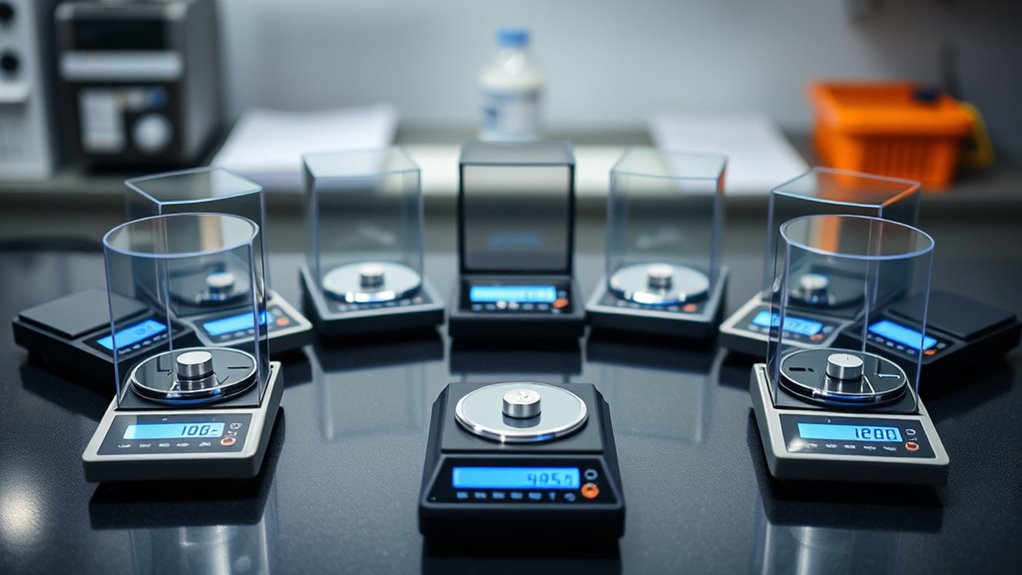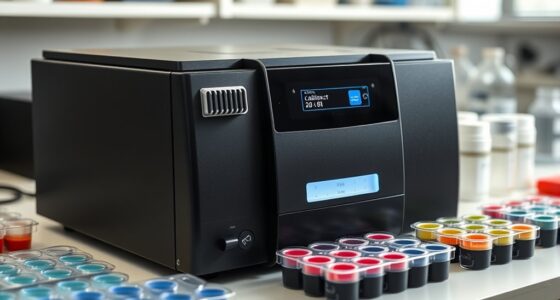If you’re looking for the best microbalance scales in 2025, I’ve reviewed a variety of top options that offer incredible precision, durability, and ease of use. From lab balances with 0.001g accuracy to body composition scales, these models suit labs, jewelry shops, and health tracking alike. Whether you need high capacity or ultra-fine resolution, I’ve got options for every need. Keep going, and I’ll help guide you to the perfect choice.
Key Takeaways
- Highlights of top microbalance scales suitable for laboratory, jewelry, and health applications in 2025.
- Features include high precision, easy calibration, and durable, portable design.
- Measurement ranges from milligrams to several kilograms with resolutions as fine as 0.001g.
- Advanced functions like auto-zeroing, multiple units, data transfer, and user-friendly interfaces.
- Selection criteria emphasize accuracy, ease of use, build quality, and compatibility with professional needs.
Lab Analytical Balance with 0.001g Accuracy Digital Scale (200g Capacity)
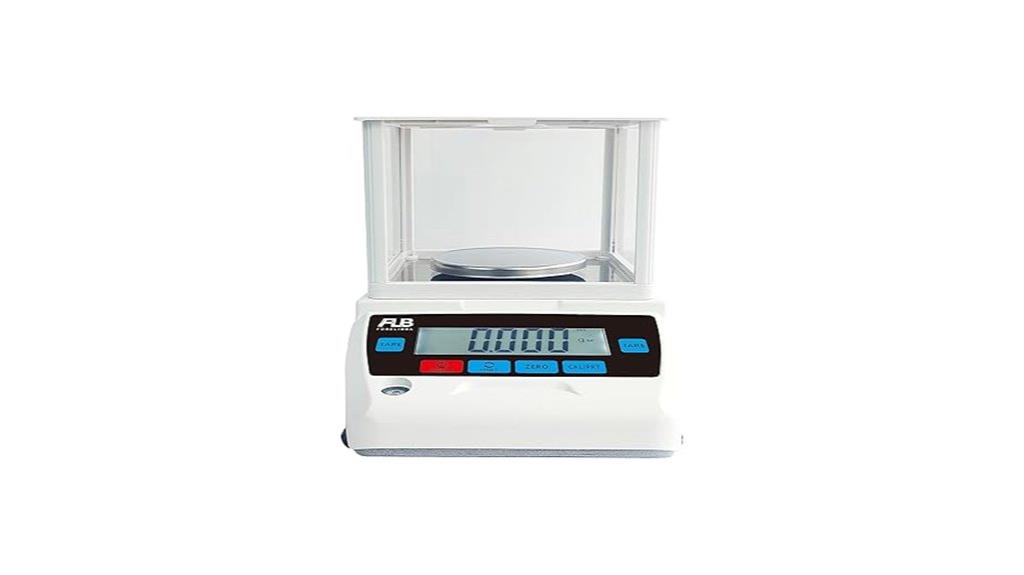
If you need highly precise measurements for laboratory, jewelry, or research work, the Lab Analytical Balance with 0.001g accuracy is an excellent choice. It provides clear, accurate results quickly with its large backlit display and glass windshield to minimize air currents. The aluminum alloy shell ensures stability and resistance to external interference. Calibration is simple with the included 200g weight, taking less than a minute. Features like multiple unit conversions, tare, overload protection, and data transfer via RS232 make it versatile. While some fluctuations can occur, careful setup and calibration help maintain its high precision, making it ideal for detailed weighing tasks.
Best For: professionals and hobbyists requiring highly precise measurements in laboratory, jewelry, and research settings.
Pros:
- Provides 0.001g (1mg) high-precision readability for accurate results
- Features a large backlit display and glass windshield for easy reading and minimized air current interference
- Supports multiple unit conversions, tare, overload protection, and RS232 data transfer for versatile use
Cons:
- Inconsistent readings and fluctuations when measuring small samples can occur
- The windshield design may sometimes affect weight accuracy, especially when placed on the chamber
- Manual calibration and setup are required to maintain high precision, which may be time-consuming
Lab Analytical Precision Scale 1000g x 0.01g
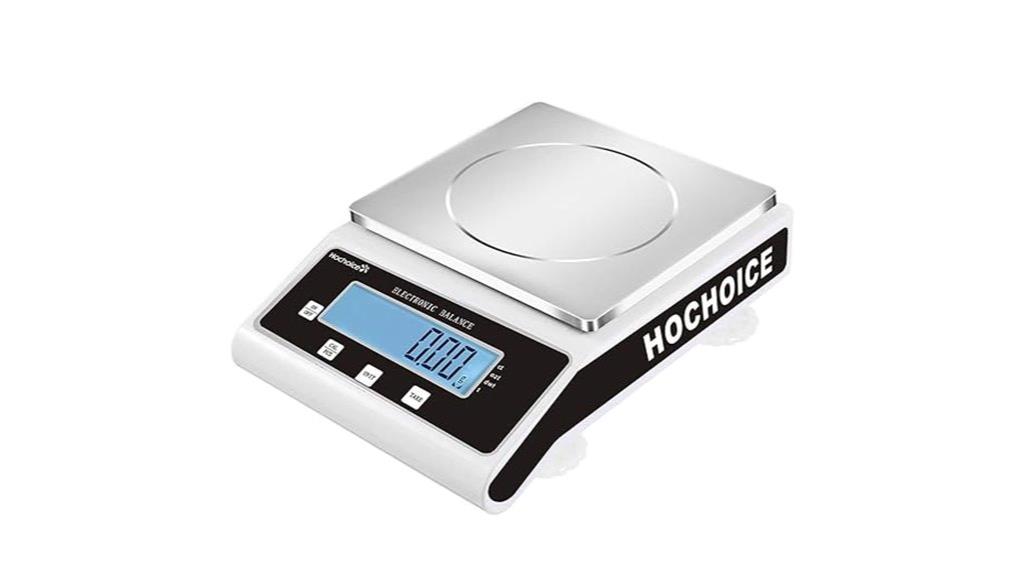
The Lab Analytical Precision Scale 1000g x 0.01g stands out as the ideal choice for professionals who demand high accuracy in laboratory, jewelry, or industrial settings. It offers a 1000g capacity with a precise 0.01g resolution, ensuring reliable measurements. Equipped with a high-precision resistance strain sensor and microcontroller, it provides stable, accurate readings. The scale features tare, external calibration, counting, and unit conversions, all displayed clearly on an LCD screen. Its durable design, automatic zero tracking, and self-inspection make it easy to operate and maintain. This versatile device is perfect for quick, precise weighing across multiple fields.
Best For: professionals in laboratories, jewelry, and industrial sectors requiring precise and reliable weighing solutions.
Pros:
- High accuracy with a 0.01g resolution and 1000g capacity for precise measurements.
- Multiple functions including tare, external calibration, counting, and unit conversions for versatile use.
- Durable design with automatic zero tracking and self-inspection features for easy maintenance and long-term performance.
Cons:
- May be more expensive than basic scales due to advanced features and high precision.
- Requires careful handling and calibration to maintain accuracy over time.
- Limited to a 0.01g resolution, which might not suit extremely fine measurement needs beyond this range.
RunStar Digital Body Scale with Body Composition Measurement
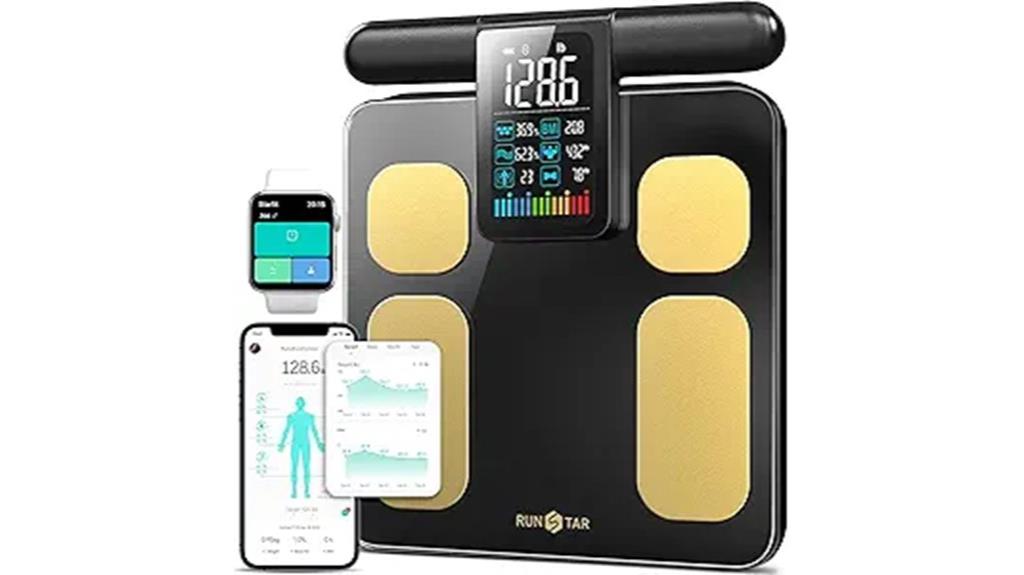
The RunStar Digital Body Scale stands out for its advanced 8-electrode segmented BIA technology, which analyzes multiple body sections for highly accurate composition readings. It measures limbs and torso to provide detailed metrics like body fat, muscle mass, water weight, and BMI. The large, vibrant display allows easy reading of weight and six other metrics without bending or opening an app. Its sleek design fits well in modern bathrooms. The Starfit app supports up to 24 users, syncing seamlessly with fitness platforms. Although some fluctuations occur, especially in body fat percentage, it remains a reliable, user-friendly device for tracking health progress over time.
Best For: individuals seeking a comprehensive, accurate, and user-friendly body composition scale for tracking health and fitness progress, especially families or groups with multiple users.
Pros:
- Utilizes advanced 8-electrode segmented BIA technology for precise measurements across multiple body sections.
- Large, vibrant display and intuitive app interface facilitate easy reading and trend monitoring without hassle.
- Supports up to 24 users with automatic recognition and seamless data syncing with popular fitness platforms.
Cons:
- Occasional fluctuations in body fat percentage readings can affect measurement consistency.
- Some users experience initial connectivity issues or difficulty recognizing multiple users.
- Reports of receiving used or damaged units, indicating potential quality control concerns.
GOYOJO Digital Laboratory Balance (5000g, 0.01g)
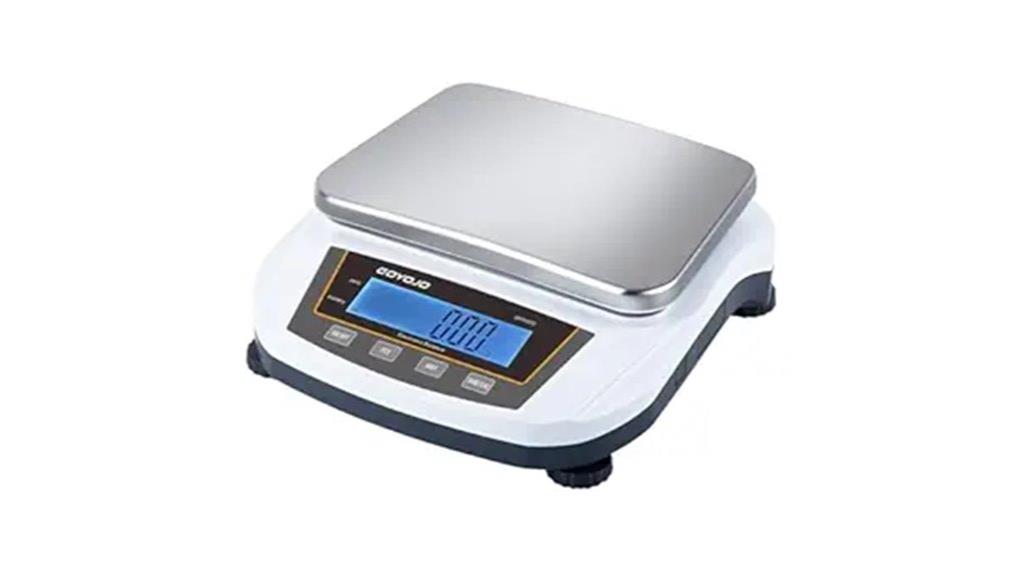
For those needing precise measurements up to 0.01 grams, the GOYOJO Digital Laboratory Balance (5000g capacity) stands out as a reliable choice. It offers high accuracy for weighing jewelry, gemstones, or small items, supporting multiple units like grams, ounces, carats, and pounds. The large LED display ensures clear readings even in low light. Made with a stainless steel platform and ABS housing, it’s durable, portable, and easy to clean. While calibration requires a separate weight and some users note stability issues, it remains a solid option for detailed, consistent measurements in labs, kitchens, or workshops.
Best For: Hobbyists, jewelers, and laboratory professionals requiring precise, small-item measurements up to 0.01 grams with versatile unit options.
Pros:
- High accuracy of 0.01g suitable for detailed weighing needs
- Supports multiple units including grams, ounces, carats, and pounds for versatility
- Durable construction with stainless steel platform and easy-to-read LED display
Cons:
- Calibration requires a separate 5000g weight which is not included
- Some users report stability issues and slight measurement inaccuracies
- Build quality may feel fragile or cheaply made to some users
THINKSCALE Milligram Scale (50g/0.001g Digital Jewelry Scale)
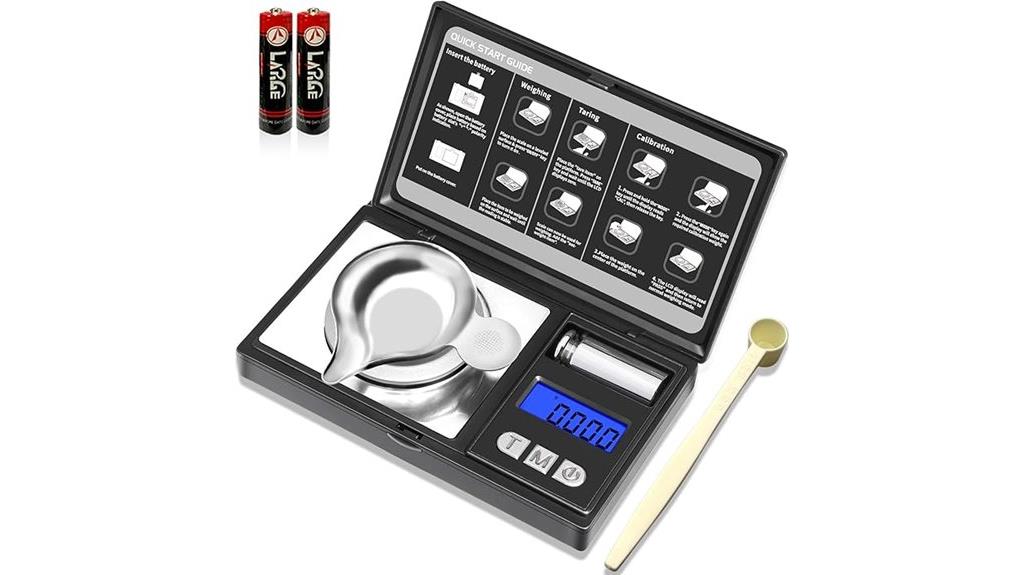
If you need pinpoint accuracy for small-scale weighing tasks, the THINKSCALE Milligram Scale stands out with its 0.001g precision and versatile unit options. It can weigh up to 50g and supports grams, ounces, troy ounces, pennyweights, carats, and grains, making it highly adaptable. The tare function guarantees accurate net measurements, while the included calibration weight maintains precision over time. Its compact, lightweight design resembles a phone, perfect for portability. The durable ABS flip cover protects the sensitive components, and the backlit LCD ensures clear readings even in low light. With a 10-year warranty and lifetime support, it’s a reliable choice for precise weighing needs.
Best For: individuals who require precise small-scale weighing for jewelry, powders, or other delicate items with high accuracy and multiple unit options.
Pros:
- High-precision sensors with 0.001g accuracy for pinpoint measurements
- Supports multiple units including grams, ounces, troy ounces, pennyweights, carats, and grains
- Compact, lightweight, and portable with a durable flip cover for protection
Cons:
- Limited maximum capacity of 50g may not suit heavier weighing needs
- Requires calibration with the included weight for maintaining accuracy over time
- Auto-off feature may turn off the device during extended use, needing reactivation
Amazon Basics Digital Kitchen Scale with LCD Display
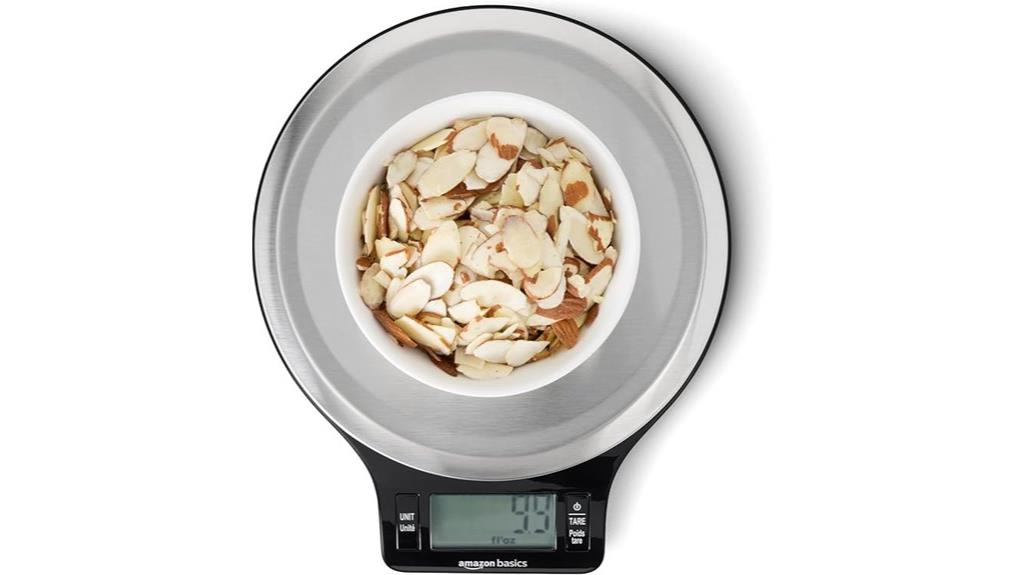
When accuracy matters most in your kitchen, the Amazon Basics Digital Kitchen Scale with LCD Display stands out as an excellent choice. It features a durable stainless steel platform and a wide LCD screen for easy reading. Capable of weighing up to 11 pounds with a minimum of 2 grams, it offers precise measurements in multiple units, including grams, ounces, pounds, fluid ounces, and milliliters. The tare function allows for quick subtractions of container weight, ensuring accurate results. Compact and lightweight, it’s powered by two included AAA batteries, making it convenient and user-friendly for everyday cooking and baking needs.
Best For: home cooks and bakers seeking precise, easy-to-read measurements for their culinary and baking needs.
Pros:
- Accurate weighing up to 11 pounds with a minimum of 2 grams for precise measurements
- Easy-to-read wide LCD display with clear results in multiple units
- Compact, durable stainless steel platform and BPA-free plastic components for safety and easy cleaning
Cons:
- Limited weight capacity may not suit very heavy items or large batches
- Requires two AAA batteries, which are not rechargeable and need replacement over time
- No advanced features like Bluetooth connectivity or smartphone integration
hand2mind Blue Nestable Pan Balance for Kids

The hand2mind Blue Nestable Pan Balance stands out as an ideal educational tool for young children learning basic measurement concepts. Its clear double balance design allows kids to easily compare weights, fostering understanding of inequalities and equivalency. Made from durable, lightweight plastic, it’s simple to assemble and store, saving space with its nestable feature. The adjustable leveling pieces and visual markings help children grasp concepts like greater than, less than, or equal to. With a plastic pan for exploring solids and liquids, it encourages hands-on learning in classrooms, homes, and daycare settings. Despite some concerns about sturdiness, its affordability and educational value make it a popular choice for early science and math exploration.
Best For: early childhood educators, parents, and homeschooling families looking for an affordable, engaging, and space-saving measurement tool for young children learning basic math and science concepts.
Pros:
- Easy to assemble, disassemble, and store thanks to nestable design
- Visual markings and adjustable leveling pieces enhance understanding of inequalities and equivalency
- Lightweight and durable plastic construction suitable for classroom use and hands-on activities
Cons:
- May lack durability and stability with rough handling or extended use
- Cups and hooks can sometimes detach or not stay securely in place
- Less precise for fine measurements, making it less ideal for advanced scientific experiments
Weigh Gram 200g Digital Pocket Gram Scale
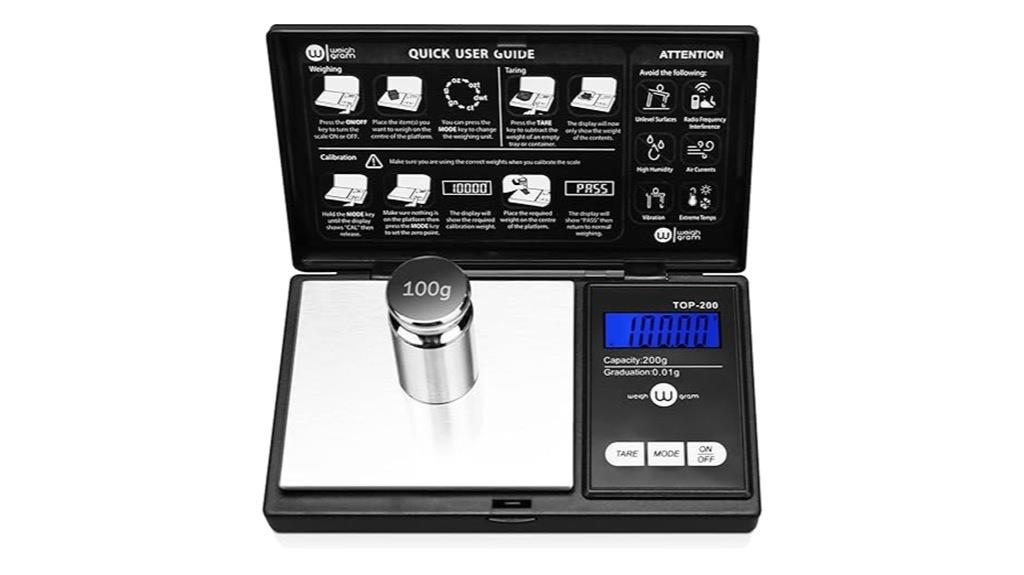
The Weigh Gram 200g Digital Pocket Gram Scale stands out as an ideal choice for anyone needing precise measurements on the go. Its compact size, measuring just 5.2 x 2.99 x 0.79 inches, makes it easy to carry everywhere. The stainless steel platform and flip cover guarantee durability and safety, while the large blue backlit LCD display provides clear readings in any lighting. With a 0.01-gram resolution and six weight modes, it’s perfect for jewelry, coins, herbs, or small items. Easy to calibrate and simple to operate, this scale combines accuracy with convenience, making it a reliable tool for various small-scale weighing needs.
Best For: hobbyists, jewelry makers, and professionals who need a compact, accurate, and portable scale for measuring small items on the go.
Pros:
- Highly accurate with 0.01g resolution and multiple weight modes for versatile use.
- Durable stainless steel platform and protective flip cover ensure longevity and safety.
- Easy calibration with included weights and user-friendly design for quick, reliable measurements.
Cons:
- Limited to 200g maximum capacity, not suitable for heavier items.
- Requires AAA batteries, which may need replacement over time.
- Auto shut-off feature might turn off the scale during prolonged measurements if not adjusted.
U.S. Solid Precision Lab Scale 5000g x 0.01g
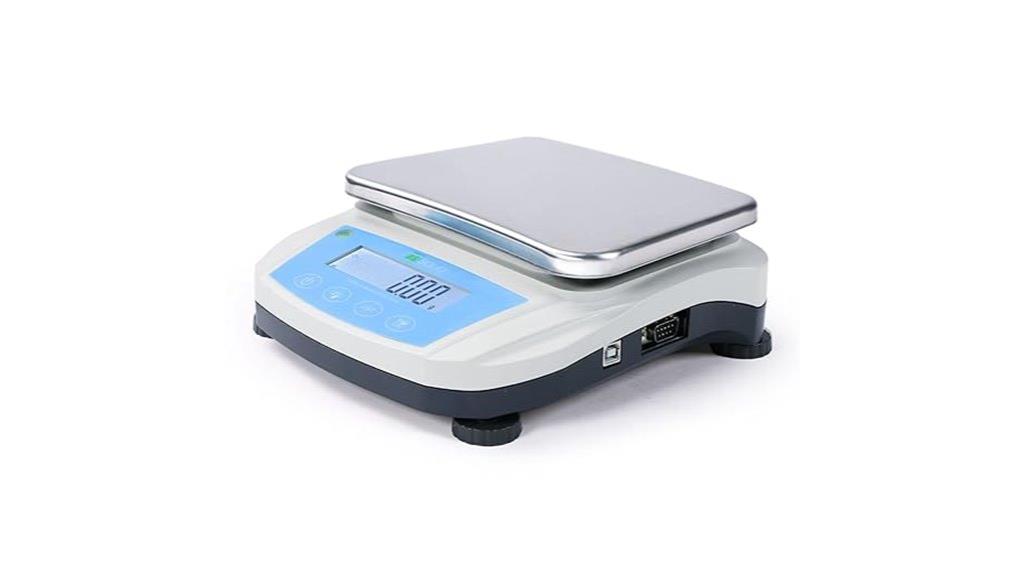
If you need a reliable scale capable of handling up to 5 kg with precise 10 mg increments, the U.S. Solid Precision Lab Scale is an excellent choice. It features a large weighing pan with bubble leveling and height-adjustable feet, ensuring stability. The LCD display with backlight makes readings clear, while dual RS232 and USB interfaces facilitate easy data transfer to printers and computers. Supporting 19 measurement units and preset combinations, it’s versatile for scientific, industrial, and general weighing tasks. Built-in functions like tare, check-weighing, and manual calibration enhance accuracy, making it a dependable tool for precise, high-capacity weighing.
Best For: individuals and professionals needing precise, high-capacity weighing for laboratories, industrial applications, or culinary tasks.
Pros:
- Accurate measurement with 10 mg readability up to 5 kg capacity
- Versatile with 19 supported measurement units and preset combinations
- Easy data transfer via dual RS232 and USB interfaces
Cons:
- May require calibration for optimal accuracy over time
- Larger size might be less suitable for very compact spaces
- Limited to 0.01 g increments, not suitable for ultra-fine measurements below that range
Industrial Counting Scale for Parts and Coins, 66lb/0.00022lb-30kg, RS232 Port
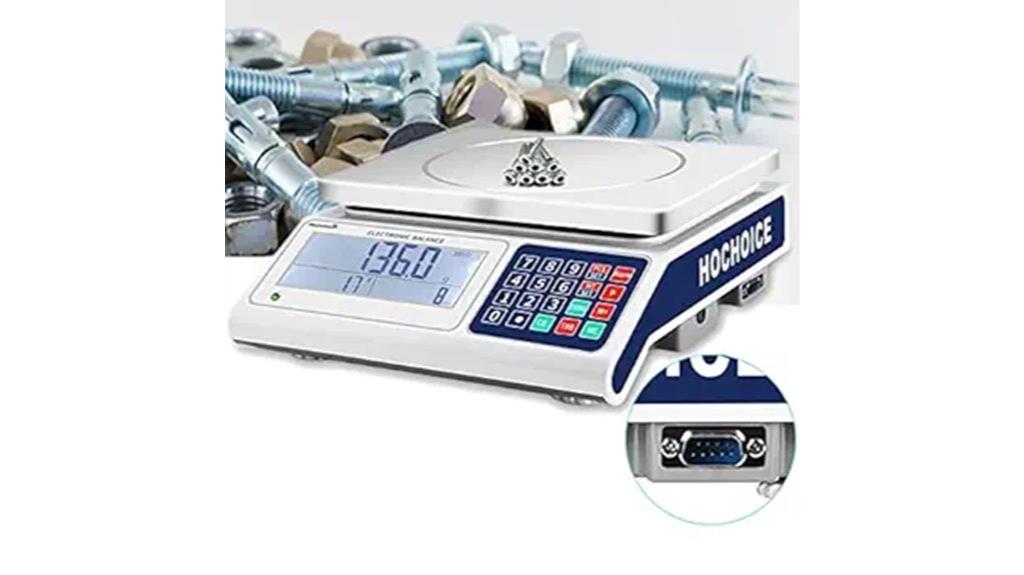
For those seeking a reliable industrial counting scale capable of handling heavier loads with impressive accuracy, the 66lb/0.00022lb-30kg model with an RS232 port stands out. It combines weighing and counting functions, supporting multiple measurement modes like grams, ounces, and pounds, with a 0.1g accuracy. Built with lab-quality sensors and microcontrollers, it delivers reliable, instant readings. The large LCD, bright backlight, and adjustable feet ensure clear display and stability. Its durable construction suits industrial environments, and the RS232 port allows easy connection to computers and printers. While lacking a tare feature, it excels in parts counting, inventory, and packaging tasks, making it a versatile choice.
Best For: industrial workers, lab technicians, and inventory managers who need a durable, high-accuracy counting scale for heavier items and parts.
Pros:
- Combines weighing and parts counting functions with multiple measurement modes for versatility.
- Built with lab-quality sensors and microcontrollers ensuring reliable, instant readings.
- Large, bright backlit LCD and adjustable feet enhance visibility and stability during operation.
Cons:
- Does not support battery operation; requires constant connection to 100-240V power supply.
- Lacks a tare/ZERO function, which may lead to negative readings after weighing.
- Limited to grams for weight measurement; manual conversion needed for other units like pounds or ounces.
GOYOJO Digital Analytical Balance and Lab Scale
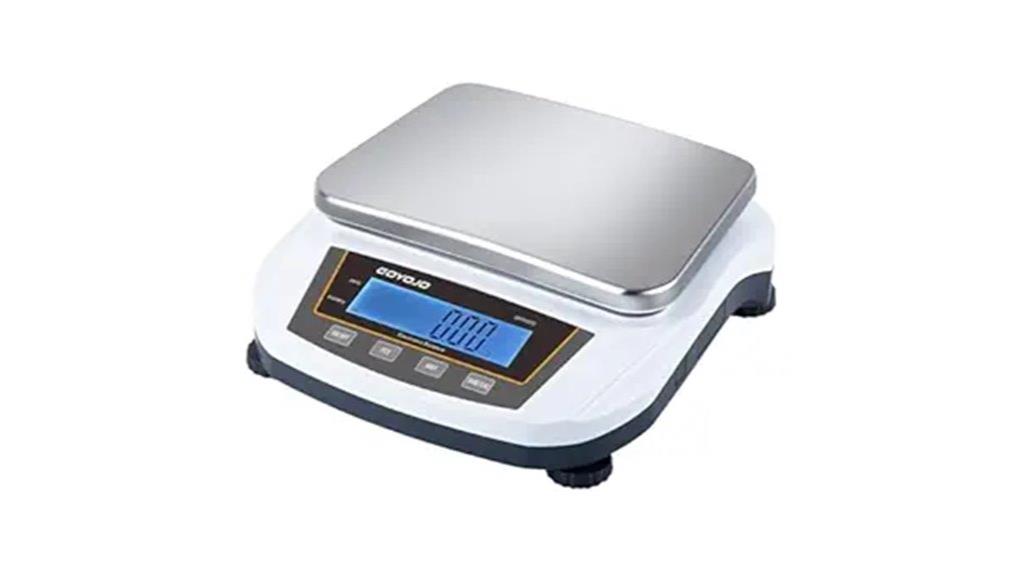
When accuracy in small-item weighing matters most, the GOYOJO Digital Analytical Balance and Lab Scale stands out with its 0.01g sensitivity and 5,000g capacity. I find it versatile for weighing jewelry, gemstones, and lab samples, supporting multiple units like grams, ounces, and carats. Its large LED display ensures clear readings even in dim lighting, making it easy to use. Built with a stainless steel platform and ABS housing, it’s durable and easy to clean. While calibration requires an external weight, its precise measurements and user-friendly design make it suitable for both professional and home use, despite some minor stability concerns.
Best For: those needing precise small-item measurements in jewelry, laboratory, or crafting settings, both professionals and home users.
Pros:
- Highly accurate with 0.01g sensitivity, suitable for detailed weighing tasks
- Supports multiple units (grams, ounces, carats, pounds) for versatility
- Durable construction with stainless steel platform and easy-to-read LED display
Cons:
- Calibration requires an external 5000g weight, which is sold separately
- Some users report stability issues and minor measurement inaccuracies
- Build quality may feel fragile or cheaply made to certain users
Factors to Consider When Choosing Microbalance Scales
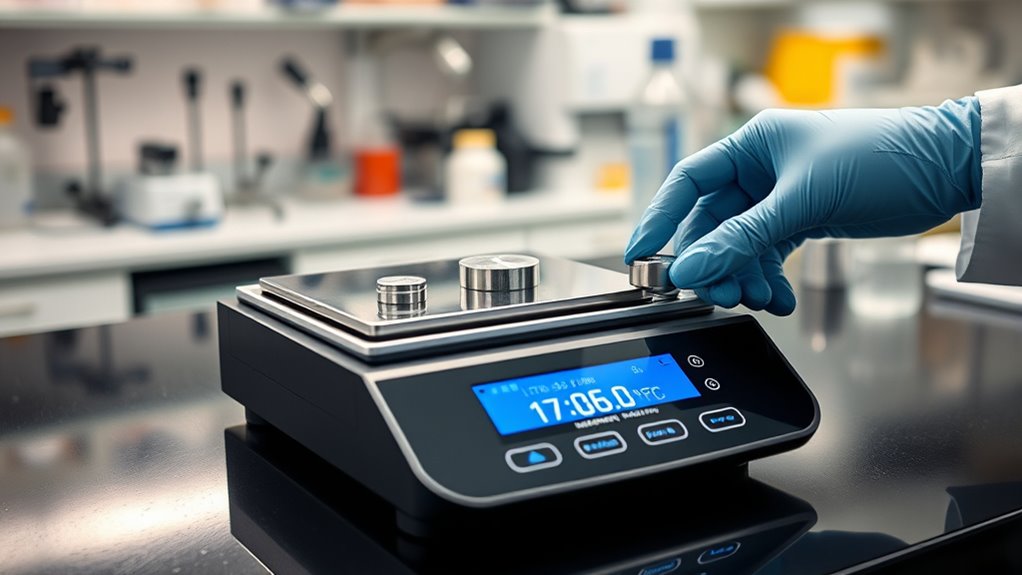
When selecting a microbalance scale, I focus on accuracy and precision to guarantee reliable results. I also consider capacity and range to match my specific weighing needs, along with calibration methods for consistent performance. Finally, I look for ease of use and connectivity options to streamline my workflow.
Accuracy and Precision
Choosing the right microbalance scale hinges considerably on its accuracy and precision, which are critical for reliable measurements. Microbalances typically offer an accuracy range of 0.0001g to 0.001g, essential for detailed scientific work. The resolution, or smallest detectable weight change, usually matches this range, ensuring sensitive measurements. To maintain accuracy over time, calibration with certified weights is crucial, reducing measurement errors. External factors like air currents, vibrations, and temperature fluctuations can compromise precision, so using a controlled environment is necessary. Proper maintenance, including regular calibration and stable placement, also helps prevent measurement drift. Focusing on these factors ensures you select a microbalance that delivers consistent, dependable results for your precision weighing needs.
Capacity and Range
Selecting the right microbalance scale involves ensuring its capacity matches your specific measurement needs. Microbalances typically range from a few milligrams up to several grams, depending on your sample size. You want a scale that can handle your maximum sample weight without overload, which could cause errors or damage. For small, lightweight samples, choose a scale designed for fine resolution—often with a maximum capacity around 50 to 200 grams. Balancing capacity with precision is key; higher capacities usually mean less detailed measurements. Exceeding the scale’s maximum can invalidate results and harm the device. _thus_, consider your typical sample weights carefully to pick a microbalance that offers both adequate capacity and the precision you require for accurate, reliable measurements.
Calibration Methods
Calibration methods play a crucial role in maintaining the accuracy and reliability of microbalance scales. Internal calibration uses built-in weights for quick, automated adjustments, making it convenient for regular checks without extra tools. External calibration involves manually placing certified weights on the scale, providing a high level of precision but requiring careful handling and proper procedures. Regular calibration adjusts for environmental factors, sensor drift, and mechanical wear, ensuring consistent measurements over time. When choosing a microbalance, consider whether internal calibration suits your workflow or if external calibration aligns better with your accuracy standards. The method impacts ease of use, measurement precision, and compliance with industry standards. Selecting the right calibration approach ensures your scale remains reliable and accurate for critical weighing tasks.
Ease of Use
When evaluating microbalance scales, ease of use is essential to guarantee accurate measurements without unnecessary hassle. A user-friendly scale features a clear, intuitive interface with simple controls for calibration, tare, and measurement. Large, backlit displays improve readability in various lighting conditions, reducing errors during delicate weighing tasks. Automated features like auto-zeroing and straightforward calibration steps help minimize setup time and effort. Designs that include easy access ports for data transfer and require minimal setup make operation accessible for users with different technical skills. Clear instructions, responsive buttons, and minimal complexity ensure efficient operation, especially when measuring tiny samples with high precision. Prioritizing ease of use ensures that the scale delivers reliable results while minimizing user frustration.
Connectivity Options
Choosing the right connectivity options for a microbalance scale can substantially streamline your workflow by simplifying data transfer and management. Modern scales often include RS232, USB, or Bluetooth, making it easy to send measurements directly to computers, printers, or software. This reduces manual data entry errors and allows for automatic logging, saving time. Some advanced models support multiple connection types simultaneously, offering greater flexibility to integrate with existing lab systems. Wireless options like Bluetooth or Wi-Fi enable remote monitoring and control, boosting efficiency in busy environments. When selecting a microbalance, consider your current data infrastructure and specific measurement needs to ensure compatibility. Proper connectivity features can greatly enhance your overall productivity and data accuracy.
Durability and Build
Selecting a microbalance with a durable build guarantees it can withstand everyday handling and environmental challenges. A sturdy housing, often made of metal or impact-resistant plastics, ensures the scale remains protected from bumps and drops. The weighing pan and internal components should resist corrosion and wear, especially in demanding laboratory or industrial settings. High-quality construction features, like reinforced joints and secure calibration mechanisms, help sustain accuracy over time despite physical stresses. Durability also involves resistance to air currents, vibrations, and temperature fluctuations, which can otherwise compromise measurement stability. Additionally, scales with robust construction typically include protective covers or shields to prevent damage and contamination during use and storage. Investing in a well-built microbalance ensures longevity and consistent precision.
Price and Budget
Microbalance scales come in a wide range of prices, from budget-friendly options under $100 to professional-grade models costing several thousand dollars. Your budget influences which features you can access—more advanced functions like automatic calibration or RS232 data interfaces usually come with higher prices. Investing in a pricier scale often means better build quality, more consistent accuracy, and greater durability, which is essential for professional use. For occasional or hobbyist purposes, a less expensive model with 0.001g precision might be sufficient. However, if you work in a lab or need reliable, precise measurements regularly, a scale costing $1,000 or more is a worthwhile investment. Ultimately, balancing your budget with your specific measurement needs helps ensure you choose a scale that’s both effective and cost-efficient.
Frequently Asked Questions
How Do Environmental Conditions Affect Microbalance Precision?
Environmental conditions notably impact microbalance precision. I’ve learned that even slight temperature fluctuations can cause expansion or contraction of materials, leading to measurement errors. Vibrations from nearby equipment or walking can shake the balance, affecting accuracy. Humidity can also cause moisture buildup, influencing the weight readings. To get reliable results, I always place my microbalance in a stable, temperature-controlled environment away from drafts and vibrations.
What Maintenance Is Required for Long-Term Accuracy?
Think of my microbalance like a fine-tuned musical instrument; regular tuning keeps it accurate. I regularly calibrate it with certified weights, clean the weighing pan, and check for environmental shifts. I also keep a maintenance log to track any issues. This routine guarantees my scale stays precise over time, much like a well-maintained instrument produces perfect music. Consistent care is key to reliable, long-term accuracy.
Are There Specific Calibration Procedures for Different Microbalances?
Yes, there are specific calibration procedures for different microbalances. I always follow the manufacturer’s instructions, which typically involve using certified calibration weights and performing routine checks at regular intervals. For some models, I calibrate using internal calibration features or software. It is crucial to document each calibration and ensure proper environmental conditions to maintain accuracy over time. Regular calibration keeps my microbalance precise and reliable for sensitive measurements.
How Does User Experience Impact Measurement Reliability?
Ever wondered how much user experience influences measurement reliability? I believe it plays a huge role, since familiarity with the device reduces errors and improves consistency. When I handle a microbalance confidently, I trust its readings more. Proper training, careful handling, and understanding the instrument’s quirks boost accuracy. So, investing in user education isn’t just helpful—it’s essential for ensuring precise, reliable measurements every time.
What Safety Features Are Essential for High-Precision Scales?
I believe essential safety features for high-precision scales include overload protection to prevent damage from excess weight, stability locks to keep the scale steady during measurement, and anti-vibration pads that minimize external disturbances. Additionally, calibration alarms alert me when the scale needs recalibration, ensuring accuracy. These features give me peace of mind, safeguard my equipment, and help maintain consistent, reliable measurements every time I use the scale.
Conclusion
So there you have it—your tiny but mighty arsenal of microbalance scales. Whether you’re weighing gold bars or just your stubbornly elusive coffee beans, these scales are like the superhero sidekicks of the lab world. Just remember, choosing the right one is as vital as knowing the difference between a milligram and a millimeter—because in the world of precision, every tiny detail counts. Happy weighing, and may your measurements always be spot on!
